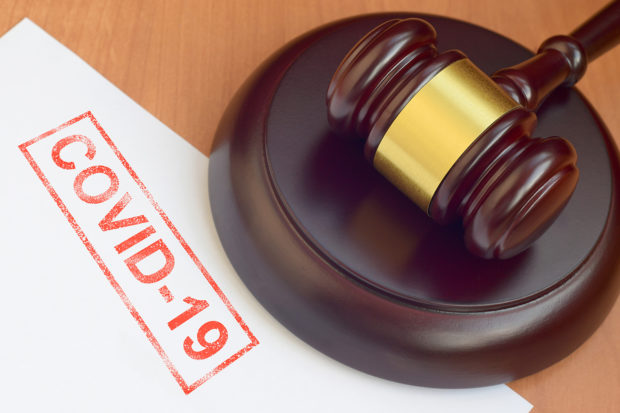“Take-home COVID” claims are claims brought against an employer by the spouse or child of an employee who caught COVID-19 in the workplace and brought it home, infecting a spouse or child and causing injuries. These claims are controversial because employees that are injured in the workplace are generally prohibited by workers compensation laws from suing their employers, in exchange for receiving workers compensation benefits.
Many courts have extended that employer’s liability protection to bar claims involving “derivative injuries” from an employee’s illness, including claims by family members. For this reason, most employers have come to expect protection from lawsuits arising out of workplace injuries or illnesses.
But the over two-dozen “take-home COVID” claims that have been filed across the country are challenging that sense of security. To protect employers, some states have enacted prohibitions on suing businesses over COVID to prevent these types of lawsuits. But most states, including California, have left take-home COVID claims to the courts.
The California Supreme Court, in Kuciemba v. Victory Woodworks, will soon decide whether California employers can be liable for take-home COVID claims. Because these claims may give rise to insurance coverage disputes, policyholders should review their insurance policies carefully to attempt to mitigate potential liability arising from take-home COVID.
Will California Allow Take-Home COVID Claims to Move Forward?
Kuciemba v. Victory Woodworks arose from a now-ubiquitous fact pattern. Kuciemba’s employer, Victory, allegedly forced Kuciemba to “work in close contact” with other workers in contravention of San Francisco health orders and safety procedures. After Kuciemba developed COVID, his 65-year-old wife contracted it from him and developed severe symptoms, requiring hospitalization. The Northern District of California dismissed the case, finding that it was barred by California’s workers compensation statute and that the employer had no duty to a non-employee.
On appeal, the California Supreme Court accepted review of the following certified questions from the U.S. Court of Appeals for the Ninth Circuit: (1) whether the “derivative injury” doctrine allows a spouse’s claim against an employer when an employee brings COVID home from the workplace; and (2) whether an employer owes a duty to the households of its employees to exercise care to prevent the spread of COVID. If the answer to either question is “no,” then take-home COVID claims will be largely barred in California.
In almost all jurisdictions, workers compensation is the sole remedy for employee injuries. Generally, in exchange for workers compensation benefits, which are provided whether or not an employer is negligent, workers give up the right to sue their employer for an injury. This is often referred to as workers compensation immunity. Under the “derivative injury” doctrine, courts have expanded employers’ immunity to claims by someone other than the employee such as a spouse who suffers emotional distress from witnessing the employee’s injuries. Courts view those kinds of claims as “derivative” of the employee’s injury and generally deem them barred by workers compensation immunity.
But the derivative injury doctrine has its limits. For example, some non-California courts have found tort claims based on “take-home hepatitis” and “take-home HIV” not derivative, and thus not barred by workers compensation immunity. Applying that reasoning to the COVID context, one California court recently found that the spouse of an employee could pursue a take-home COVID claim because the spouse’s death from COVID-19, although causally related to the employee’s COVID infection, was not legally derivative of that infection. Given that ruling and the out-of-state analogous cases, it appears highly likely that the California Supreme Court in Kuciemba will find that the derivative injury doctrine does not bar take-home COVID claims.
It is also possible that the California Supreme Court could find that employers owe a duty of care to employee households to prevent employees from getting COVID and bringing it home. Businesses normally owe only a duty of “ordinary” care to others, which does not generally require a company to prevent injury to non-employees. However, the California Supreme Court has created exceptions based on multiple factors, essentially boiling down to the foreseeability of the relevant injury and the public policy concerns supporting the creation of an exception. In an analogous case, the California Supreme Court held that an employer had a duty to prevent injury to family members when an employee carried asbestos fibers home. It seems likely that the upcoming decision in Kuciemba will follow the same line of reasoning and confirm an employer’s duty to employees’ families for take-home COVID claims.
If Take-Home COVID Lawsuits Are Allowed, Will the Claims Be Covered by Insurance?
If take-home COVID claims are allowed, businesses will look to their insurance coverage—and may find some unpleasant surprises. The first policy to evaluate will be commercial general liability (CGL) insurance. CGL insurance protects policyholders against third-party claims for property damage or bodily injury, such as COVID-19.
However, insurers may recite a variety of exclusions in the CGL to attempt to deny coverage, including communicable disease exclusions or employment-related practices exclusions.
Communicable Disease Exclusion: Many CGL policies now include communicable disease exclusions. Although language varies, these exclusions may bar coverage for bodily injury arising out of the actual or alleged transmission of a communicable disease, which in turn may be defined to specifically include COVID-19. Some communicable disease exclusions may also specifically state that they apply even if a claim alleges negligence in: (a) supervising, hiring, employing, training or monitoring of others that may be infected with and spread a communicable disease; (b) testing for a communicable disease; (c) failure to prevent the spread of the disease; or (d) failure to report the disease to authorities.
Although rare in CGL insurance policies before the COVID-19 pandemic, the potential liability associated with the virus has driven many insurers to add communicable disease exclusions to their policies. But because CGL coverage is occurrence-based, coverage may still be available under the policy in force when the take-home COVID injury occurred, even if an exclusion was subsequently endorsed onto a policy. Employers should carefully evaluate any COVID claim to determine exactly when injury first occurred to maximize potential coverage.
Employment-Related Practices Exclusion: Employment-related practices exclusions are standard-form exclusions that typically apply to: 1) bodily injury to a person arising out of any employment-related practices, policies, acts or omissions; or 2) bodily injury to the spouse, child, parent, brother or sister of that person as a consequence of bodily injury to the person at whom any of the employment-related practices is directed. Although the language of this exclusion is broad, courts often limit its application to practices relating to the content of the employment relationship. In HS Services v. Nationwide Mut. Ins. Co., for example, the Ninth Circuit applied California law to find that where the relationship between the employer’s act or omission and the substance of the employment was “too indirect and attenuated,” the exclusion would not apply.
Therefore, in a take-home COVID case, even if the spread of COVID to a spouse or child is found to be factually related to employment, and to a negligent practice by the employer with regard to employee health and safety, a policyholder could argue that the injury did not result from an employment practice that is substantially related to the employment relationship. Moreover, the exclusion’s application to a spouse or child is questionable, because the “part 2” of the exclusion requires bodily injury to the employee, and then derivative injury to the spouse or child. But in a take-home COVID case it doesn’t matter whether the employee is herself injured—only that the virus was brought home by the employee, which can occur without the employee being sick. In that way, the application of this exclusion somewhat mirrors the “derivative injury” test for workers compensation immunity.
Beyond CGL coverage, other insurance policies may apply to take-home COVID claims, so policyholders should consult with counsel to discuss how best to maximize coverage under all potentially applicable policies.
Because it seems likely that the California Supreme Court in Kuciemba will allow take-home COVID claims to proceed, California businesses (and indeed employers everywhere) should review all insurance policies in effect from March 2020 and onward to address any insurance coverage issues that may arise if take-home COVID claims are permitted to proceed.
This article was originally published by Claims Journal, CM’s sister publication.




















 NOAA Announces Latest AI-Driven Global Weather Models
NOAA Announces Latest AI-Driven Global Weather Models  Market Softening Accelerates During 1/1/2026 Re Renewals
Market Softening Accelerates During 1/1/2026 Re Renewals  Executives on the Move at Liberty Mutual, Cowbell, W. R. Berkley
Executives on the Move at Liberty Mutual, Cowbell, W. R. Berkley 
